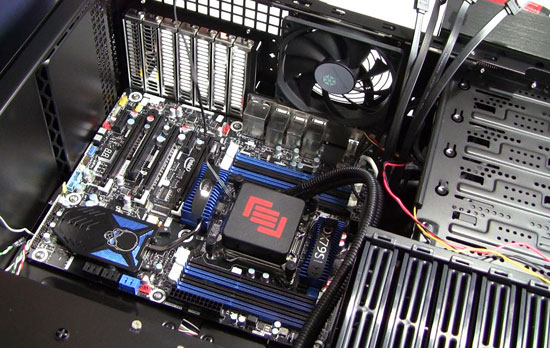Building The SHIFT, Maingear's DIY Kit
System Installation, Setup and EPIC Audio
Once you get the motherboard in place, along with some of its critical power cabling routed, the rest of the build goes fairly easily. The motherboard of choice for our build was Intel's very own DX79SI "Siler" motherboard. With only three full-length PCI Express slots (Gen 3 capable though not validated by Intel yet) and a pair of x1s, there's not a ton of room for expansion, though it served our standard NVIDIA SLI multi-GPU setup just fine.

Intel's DX79SI Siler Motherboard, Maingear EPIC 180 water block installed




Intel's DX79SI Siler Motherboard, Maingear EPIC 180 water block installed

We actually opted to leave the SATA cables you see here, running on the front side of the motherboard, so we could get at them easier if need be in the future. You could easily use one of the local pass-throughs though, if you wanted to neaten things up a bit more.


The OCZ RevoDrive X2 sits nestled in next to the MSI GeForce GTX 580 in this shot but there would be another GTX 580 from Zotac flanking that PCIe SSD in the near future. Air flow across the card slot area was going to be critical for system stability under load, so we dialed up that 180mm fan to sit at 70% in the BIOS. Fortunately, at that speed, it's still whisper-quiet. The back side of the chassis shows most of where our cables are hiding. The SHIFT's panel design has plenty of room on either side to offer clearance for accommodating all the cabling we could throw at it. Pop the side panel on and it's out of site, out of mind, as they say.
A Few Minutes with EPIC Audio, Powered by APHEX:
APHEX is Pro Audio technology company that has been around for about 35 years specializing in audio processing and production equipment primarily, though they do license their technology as well. Maingear got together with Aphex to develop an audio enhancement engine for PC gamers, specifically for the headphone-powered crowd. As part of the bundle, this little number was installed in a 2.5" drive-bay for us.


A Few Minutes with EPIC Audio, Powered by APHEX:
APHEX is Pro Audio technology company that has been around for about 35 years specializing in audio processing and production equipment primarily, though they do license their technology as well. Maingear got together with Aphex to develop an audio enhancement engine for PC gamers, specifically for the headphone-powered crowd. As part of the bundle, this little number was installed in a 2.5" drive-bay for us.


Maingear's EPIC Audio Engine (powered by APHEX as you can see) offers what Maingear calls "a more immersive PC experience through enhanced sound. The studio-grade processing technology in a custom designed solution for PCs, headphone audio output and microphone input truly gives a more balanced and realistic audio experience."
In our testing of both in-game sound effects, in-game musical sound tracks and various selections from our personal music library, the EPIC Audio Engine did offer a more dynamic "spatialized" effect with brighter highs and more pronounced, punchy lows. Though APHEX claims that sound will be more "balanced and articulated" we'd offer that, depending on your personal preference and listening style, the EPIC Audio Engine's seemingly enhanced dynamic range may or may not appeal to you, depending on the content you're listening to. For example, in game testing, both for sound effects and scene music, we preferred the more cinematic punch and range of the processing engine. However, certain types of music (Blues and acoustic sets) appealed more to us with the processing engine turned off. Midrange also seems a bit softened with the effect turned on as well. However, driving Rock with lots of guitar crunch sounded great with the EPIC Audio Engine enabled. Of course, our opinion here is all very much subjective, personal preference, but by in large we enjoyed having the ability to amp up the audio experience when the mood struck. We only wish the effect was available with standard audio output and not just headphones. We tested the device in conjunction with the Intel motherboard's on-board audio solution and would have like the option to enable it on our room speakers as well.
In our testing of both in-game sound effects, in-game musical sound tracks and various selections from our personal music library, the EPIC Audio Engine did offer a more dynamic "spatialized" effect with brighter highs and more pronounced, punchy lows. Though APHEX claims that sound will be more "balanced and articulated" we'd offer that, depending on your personal preference and listening style, the EPIC Audio Engine's seemingly enhanced dynamic range may or may not appeal to you, depending on the content you're listening to. For example, in game testing, both for sound effects and scene music, we preferred the more cinematic punch and range of the processing engine. However, certain types of music (Blues and acoustic sets) appealed more to us with the processing engine turned off. Midrange also seems a bit softened with the effect turned on as well. However, driving Rock with lots of guitar crunch sounded great with the EPIC Audio Engine enabled. Of course, our opinion here is all very much subjective, personal preference, but by in large we enjoyed having the ability to amp up the audio experience when the mood struck. We only wish the effect was available with standard audio output and not just headphones. We tested the device in conjunction with the Intel motherboard's on-board audio solution and would have like the option to enable it on our room speakers as well.






